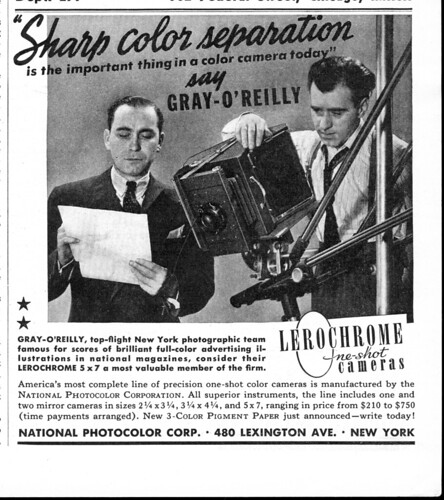Difference between revisions of "Lerochrome"
(start new page; copied advert image from three-color camera and cited another featuring a different model.) |
Hanskerensky (talk | contribs) m (→Links: Redirected Link URL to archived version) |
||
| (7 intermediate revisions by 3 users not shown) | |||
| Line 1: | Line 1: | ||
| − | + | ||
<div class="floatright plainlinks" style="margin:0px 0px 15px 15px;"> | <div class="floatright plainlinks" style="margin:0px 0px 15px 15px;"> | ||
{{Flickr_image | {{Flickr_image | ||
| Line 5: | Line 5: | ||
|image= http://farm6.staticflickr.com/5133/5517256625_8a502e5bd9.jpg | |image= http://farm6.staticflickr.com/5133/5517256625_8a502e5bd9.jpg | ||
|image_align= | |image_align= | ||
| − | |image_text= Advertisement for Lerochrome 'one-shot' three-color cameras<br/>''Popular Photography'', February 1940. <small>Scan by {{Image author|camerawiki}}</small> | + | |image_text= Advertisement for Lerochrome 'one-shot' three-color cameras<br/>''[[Popular Photography]]'', February 1940. <small>Scan by {{Image author|camerawiki}}</small> |
|image_by= | |image_by= | ||
|image_rights= public domain US no copyright | |image_rights= public domain US no copyright | ||
| Line 12: | Line 12: | ||
'''Lerochrome''' is the name of a range of [[three-color camera]]s made by the '''National Photocolor Corporation''' of New York in the 1930s and '40s. Cameras were made in three sizes: 2¼x3¼ inch, 3¼x4¼ inch (quarter plate), and 5x7 inch, and could use glass plates, cut film or film packs. They are for a 'one-shot' three-color process; that is, three plates, each exposed through a different colored filter, are exposed simultaneously, and the images combined to make one color image. Thus the cameras have three positions for plate-holders, and internal mirrors to split the image-forming light between them. | '''Lerochrome''' is the name of a range of [[three-color camera]]s made by the '''National Photocolor Corporation''' of New York in the 1930s and '40s. Cameras were made in three sizes: 2¼x3¼ inch, 3¼x4¼ inch (quarter plate), and 5x7 inch, and could use glass plates, cut film or film packs. They are for a 'one-shot' three-color process; that is, three plates, each exposed through a different colored filter, are exposed simultaneously, and the images combined to make one color image. Thus the cameras have three positions for plate-holders, and internal mirrors to split the image-forming light between them. | ||
| − | A 1939 advertisement offers the quarter-plate Lerochrome 'Daylight Special' camera,<ref>[https://books.google.co.uk/books?id=w1wzAQAAMAAJ&lpg=PA1&lr&rview=1&pg=PA121#v=onepage&q&f=true Advertisement for Lerochrome cameras] by National Photocolor Corp., featuring the quarter-plate 'Daylight Special', in ''Popular Photography'' Vol. 5, No. 5 (November 1939), p121; at Google Books.</ref> with an 8¼-inch f/4.5 Meyer Aristostigmat in Compound shutter, and with a coupled rangefinder and parallax-corrected viewfinder. A ground-glass focusing screen can also be used. The dimensions of the camera are 6½x9x9 inches, and its weight 7½ pounds (3 kg). It is metal-bodied, with black crinkle-finish paint and chrome-plated fittings. | + | A 1939 advertisement offers the quarter-plate Lerochrome 'Daylight Special' camera,<ref>[https://books.google.co.uk/books?id=w1wzAQAAMAAJ&lpg=PA1&lr&rview=1&pg=PA121#v=onepage&q&f=true Advertisement for Lerochrome cameras] by National Photocolor Corp., featuring the quarter-plate 'Daylight Special', in ''Popular Photography'' Vol. 5, No. 5 (November 1939), p121; at Google Books.</ref> with an 8¼-inch f/4.5 [[Meyer]] Aristostigmat in Compound shutter, and with a coupled rangefinder and parallax-corrected viewfinder. A ground-glass focusing screen can also be used. The dimensions of the camera are 6½x9x9 inches, and its weight 7½ pounds (3 kg). It is metal-bodied, with black crinkle-finish paint and chrome-plated fittings. |
| Line 18: | Line 18: | ||
<references/> | <references/> | ||
| + | |||
| + | ==Links== | ||
| + | * [http://www.nationalphotocolor.com/ National Photocolor Corporation] website; the company makes optical pellicle mirrors and filters. | ||
| + | * [https://web.archive.org/web/20190903110319/http://trichromie.free.fr/trichromie/index.php?post/2007/12/26/547-troisime-achat Lerochrome 5x7] camera featured in a post at the French-language blog, [https://web.archive.org/web/20190903073020/http://trichromie.free.fr/trichromie/index.php Le blog de la Trichromie] (archived) | ||
[[Category:Three-color cameras]] | [[Category:Three-color cameras]] | ||
[[Category:Quarter plate]] | [[Category:Quarter plate]] | ||
[[Category:5x7in]] | [[Category:5x7in]] | ||
| + | [[Category:6x9]] | ||
| + | [[Category:USA]] | ||
| + | [[Category:L]] | ||
Latest revision as of 06:59, 12 March 2022

|
| Advertisement for Lerochrome 'one-shot' three-color cameras Popular Photography, February 1940. Scan by camerawiki (Image rights) |
Lerochrome is the name of a range of three-color cameras made by the National Photocolor Corporation of New York in the 1930s and '40s. Cameras were made in three sizes: 2¼x3¼ inch, 3¼x4¼ inch (quarter plate), and 5x7 inch, and could use glass plates, cut film or film packs. They are for a 'one-shot' three-color process; that is, three plates, each exposed through a different colored filter, are exposed simultaneously, and the images combined to make one color image. Thus the cameras have three positions for plate-holders, and internal mirrors to split the image-forming light between them.
A 1939 advertisement offers the quarter-plate Lerochrome 'Daylight Special' camera,[1] with an 8¼-inch f/4.5 Meyer Aristostigmat in Compound shutter, and with a coupled rangefinder and parallax-corrected viewfinder. A ground-glass focusing screen can also be used. The dimensions of the camera are 6½x9x9 inches, and its weight 7½ pounds (3 kg). It is metal-bodied, with black crinkle-finish paint and chrome-plated fittings.
Notes
- ↑ Advertisement for Lerochrome cameras by National Photocolor Corp., featuring the quarter-plate 'Daylight Special', in Popular Photography Vol. 5, No. 5 (November 1939), p121; at Google Books.
Links
- National Photocolor Corporation website; the company makes optical pellicle mirrors and filters.
- Lerochrome 5x7 camera featured in a post at the French-language blog, Le blog de la Trichromie (archived)